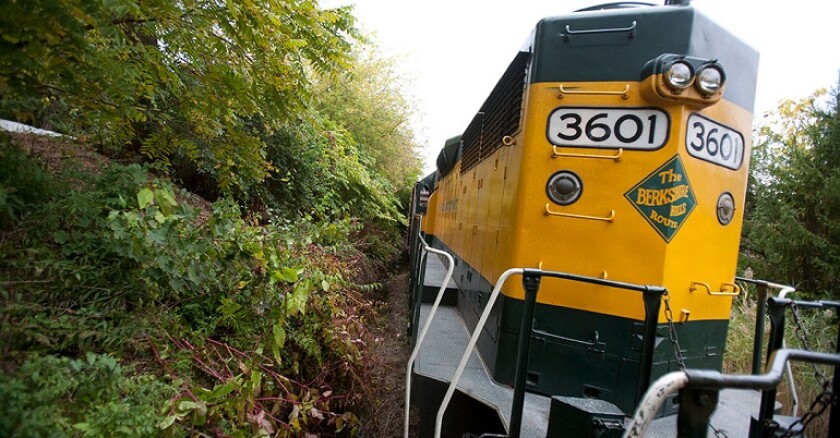This is probably because for most of the last century New Yorkers came to the Berkshires via multiple train lines. The last direct one to Great Barrington shut down in 1971. But the cultural patterns still exist. New Yorkers continue to come to enjoy the scenery, good restaurants and vibrant arts scene. Now they just mostly come by car, about three hours on a good day.
But regular passenger train service may be on the way back to Great Barrington and neighboring towns. Rail advocates, government leaders and planners are working to revive the Housatonic line, whose tracks are now operated by a freight company with the same name. It’s a complicated endeavor, mostly because three states -- Connecticut, Massachusetts and New York -- must get on board.
The Berkshires’ train revival advocates have had some initial success. Massachusetts has spent $12.1 million to buy its portion of the line from the freight company, which in turn has backed the project with studies and design work. The chief obstacle now is Connecticut, whose governor, Dannel Malloy, has not embraced the project, perhaps because he has been busy reviving train lines in another part of his state. There’s also a competing proposal being studied by the Massachusetts Department of Transportation. The Berkshire Flyer would bring trains in from the west, starting in Albany, N.Y. This would be less useful to Great Barrington because the trains wouldn’t stop there, but it might be less expensive because the tracks are in better shape.
Whatever happens in Massachusetts, people are working all over the country to bring back regional passenger train service. Elsewhere in New England, the Cape Cod Regional Transit Authority has had great success with its CapeFlyer, a summer weekend train that restored service to Hyannis, allowing beachgoers to avoid sitting in traffic in the summer sun. Maine, through its Northern New England Passenger Rail Authority, has set up the Downeaster, operated by Amtrak. It runs 145 miles from Boston up to Portland and beyond, and is used by about half a million people a year.
Over on the other coast, trains run by the Sonoma-Marin Area Rail Transit take passengers about 70 miles into Sonoma Wine Country, making 10 stops, with more planned. In New Mexico, the Rail Runner Express travels between Santa Fe and Albuquerque. All Aboard Florida, a private company, has its so-called Brightline under construction to offer service between Orlando and Miami (see “All Aboard?,” page 32). And Amtrak has expanded its own service in several regions, including between Seattle and Portland where December’s fatal derailment occurred.
Service on these lines is aimed at commuters, sometimes business travelers, sometimes tourists, often a mix. But the bottom line is the same: We have a transportation capacity challenge, and trains are a prominent piece of the solution.
An interstate-style highway can only fit about 1,800 to 2,000 vehicles per lane per hour. A train can easily carry 10 or even 20 times the number of people who can fit into private cars on a highway lane. “A double-track railroad can handle the same amount of traffic as a 16-lane highway,” says James Abram “Abe” Zumwalt, director of policy research for the National Association of Railroad Passengers.
This country’s secret resource is the thousands of miles of unused railroad right-of-way concealed mostly beneath weeds. At its peak back around 1920, the United States had more than 300,000 miles of active track. Many, if not most, of these rights-of-way go straight into the middle of towns and cities in a manner that’s almost impossible, or at least extremely costly, to do anew. And some of these lines include pieces of fabulous infrastructure that would be prohibitively expensive to build today, such as the magnificent arched bridge north of Scranton, Pa.
There’s more at stake than just moving people. As transportation scholar John Stilgoe noted in his 2007 book Train Time, private interests have been quietly buying up land around railroad rights of way, convinced that they are future gold mines. Karen Christensen, who is leading the campaign to revive service from New York to the Berkshires, says bringing back the Housatonic line would invigorate economic activity in the region. And there’s a more community-oriented goal, she says: “This line would restore the old connections between the towns along the line.”
The political difficulty, as always, is money. The capital costs of restoring the Housatonic line to passenger-grade service are estimated at more than $200 million. That’s hefty. But ultimately this resource is too valuable not to be used. A balanced transportation system, supported with public funds where needed, is best. Perhaps someday I’ll ride a train from Grand Central Terminal to Great Barrington, where a driverless car will carry me the last mile to my lodgings. It’s a future I can see.









